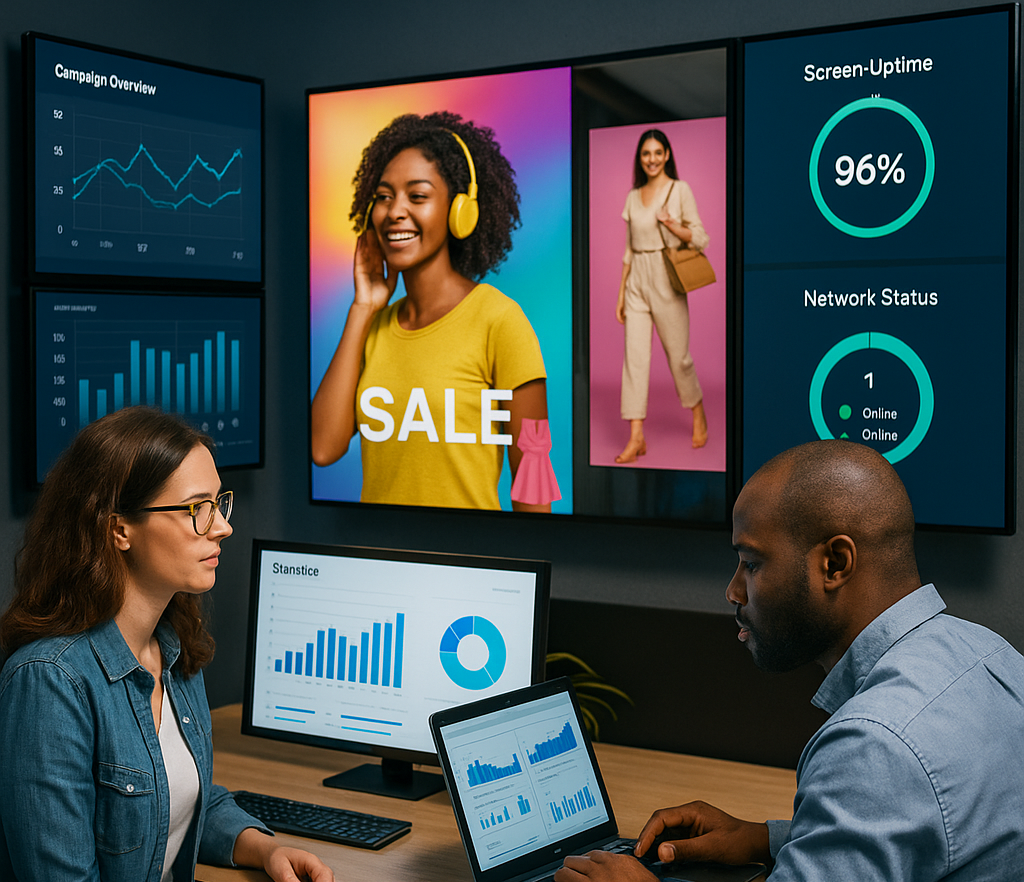Events in 2025 are more dynamic than ever, with organizers seeking innovative ways to engage attendees and streamline operations. Event signage has evolved from static posters to digital solutions that offer flexibility, interactivity, and real-time updates. Digisigns, a leader in digital signage, is at the forefront of this transformation, providing tools that elevate event experiences. From trade shows to festivals, Digisigns solutions help organizers create seamless, memorable events that leave a lasting impression. This blog post explores how digital signage for events is shaping the future, offering practical strategies for leveraging Digisigns platform in 2025.
The Evolution of Event Signage in 2025
Event signage has come a long way from printed banners and directional arrows. In 2025, digital signage for events is the gold standard, driven by attendees’ expectations for personalized, interactive experiences. Organizers are under pressure to deliver events that are not only visually appealing but also efficient and data-driven. Digisigns solutions meet these demands by offering a cloud-based platform that enables real-time updates, ensuring attendees always have access to the latest information. Whether it’s a last-minute schedule change at a conference or a flash promotion at a festival, digital signage for events ensures organizers can adapt on the fly. This flexibility is crucial in a fast-paced event environment where timing is everything.
Moreover, 2025 event trends show a shift toward hybrid and virtual components, even for in-person events. Attendees expect seamless integration of digital tools, such as live-streamed sessions or interactive maps, which event signage can facilitate. Digisigns platform supports these trends by allowing organizers to display dynamic content across multiple screens, ensuring consistency whether attendees are on-site or joining remotely. By embracing digital signage for events, organizers can create cohesive experiences that cater to diverse audiences, setting the stage for success.
Real-Time Event Updates: Keeping Attendees Informed
One of the biggest challenges in event management is keeping attendees informed of changes, such as session cancellations or venue updates. Traditional signage falls short here, as it can’t be updated once printed. Digisigns solves this with real-time event updates, a feature that allows organizers to push changes to all screens instantly. For example, at a tech conference, if a keynote speaker’s session is rescheduled, organizers can use Digisigns cloud-based dashboard to update the agenda across all event signage screens within seconds. This ensures attendees are never left confused, enhancing their overall experience.
Real-time updates also enable organizers to share time-sensitive promotions or announcements. Imagine a music festival where a popular band announces a surprise performance. With Digisigns, organizers can display this update on event signage throughout the venue, driving excitement and attendance. This capability not only improves attendee satisfaction but also showcases how digital signage for events can be a game-changer in 2025, allowing organizers to respond to the unexpected with ease.
Interactive Displays: Engaging Attendees Like Never Before
Interactive displays are a hallmark of modern event signage, transforming passive viewers into active participants. Digisigns offers touch-enabled screens that allow attendees to engage directly with content, whether it’s navigating a venue map, browsing a conference agenda, or participating in live polls. At a trade show, for instance, attendees can use Digisigns interactive displays to explore exhibitor booths, view product demos, or schedule meetings—all from a single screen. This hands-on approach not only boosts engagement but also reduces the need for printed materials, aligning with 2025’s push for paperless events.
Interactive displays also enhance wayfinding, a critical aspect of large events. At a festival spanning multiple stages, attendees can tap on a Digisigns screen to find the quickest route to their desired location, complete with real-time crowd updates. This feature minimizes frustration and ensures attendees spend more time enjoying the event. By integrating interactive displays into event signage, Digisigns helps organizers create experiences that are both functional and engaging, setting a new standard for events in 2025.
Event Analytics: Measuring Success and Optimizing Impact
Understanding attendee behavior is key to improving future events, and Digisigns event analytics tools provide organizers with valuable insights. By tracking how attendees interact with digital signage for events—such as which sessions they view or how long they spend at a screen—organizers can gain a deeper understanding of what works and what doesn’t. For example, at a corporate conference, Digisigns analytics might reveal that attendees frequently view networking session details, indicating a high demand for such opportunities. Organizers can use this data to plan more networking events in the future, tailoring the experience to attendee preferences.
Event analytics also help optimize content in real time. If a particular announcement isn’t resonating with attendees, organizers can use Digisigns dashboard to swap it for something more engaging, such as a live social media feed. Speaking of which, Digisigns allows organizers to display live feeds from platforms like LinkedIn or Instagram, encouraging attendees to share their experiences using event-specific hashtags. This not only boosts engagement but also amplifies the event’s reach online. In 2025, where data-driven decisions are paramount, Digisigns event analytics empower organizers to create more impactful events.
The Future of Event Signage: Trends to Watch in 2025
As event signage continues to evolve, several trends are shaping its future in 2025. Personalization is a major focus, with attendees expecting content tailored to their interests. Digisigns platform supports this by integrating with event apps to display personalized agendas or recommendations on screens. For instance, a conference attendee might see a reminder for a session they’ve registered for as they pass a Digisigns screen, enhancing their experience.
Another trend is the rise of augmented reality (AR) in event signage. While still emerging, AR-enabled digital signage for events allows attendees to interact with virtual elements, such as 3D product models or immersive maps, by scanning a screen with their smartphone. Digisigns is well-positioned to adopt such technologies, ensuring they remain at the forefront of innovation. These trends highlight how event signage is becoming a critical tool for creating memorable, tech-forward experiences in 2025.
Conclusion: Elevate Your Events with Digisigns Solutions
In 2025, event signage is more than just a way to share information—it’s a tool for creating engaging, seamless experiences that delight attendees. Digisigns solutions empower organizers to stay ahead of the curve, offering real-time updates, interactive displays, and event analytics that drive success. Whether you’re hosting a trade show, festival, or conference, digital signage for events can transform how you connect with your audience. Ready to elevate your next event? Explore Digisigns innovative platform at digisigns.in and see the difference for yourself. How are you planning to enhance your events this year? Share your thoughts!
Frequently Asked Questions (FAQs)
1. How does Digisigns ensure real-time updates for event signage?
Digisigns uses a cloud-based platform that allows event organizers to update content across all screens instantly. Whether it’s a schedule change or a last-minute announcement, organizers can log into the Digisigns dashboard from any device and push updates in seconds, ensuring attendees always have the latest information.
2. What types of events can benefit from Digisigns digital signage solutions?
Digisigns digital signage solutions are versatile and can enhance a wide range of events, including trade shows, conferences, music festivals, corporate events, and exhibitions. Any event that requires dynamic content, wayfinding, or attendee engagement can benefit from Digisigns features like interactive displays and real-time updates.
3. Can Digisigns interactive displays help with event wayfinding?
Yes, Digisigns offers touch-enabled interactive displays that make wayfinding easy. Attendees can tap on a screen to access venue maps, find session locations, or get real-time crowd updates, which is especially useful for large events like festivals or conferences with multiple areas.
4. How can event analytics from Digisigns improve future events?
Digisigns event analytics track how attendees interact with digital signage, such as which content they view or how long they engage. This data helps organizers understand attendee preferences, optimize content in real time, and plan future events more effectively by focusing on what resonates most.
5. Is Digisigns prepared for emerging event signage trends like augmented reality (AR)?
Absolutely. Digisigns is well-positioned to adopt emerging trends like AR in event signage. While AR is still developing, Digisigns platform can support future integrations, allowing attendees to interact with virtual elements like 3D models or immersive maps by scanning screens with their smartphones.


